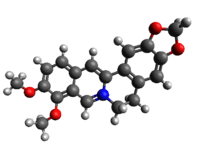Berberine
 | |
 | |
| Names | |
|---|---|
| Other names
umbellatine; 5,6-dihydro-9,10-dimethoxybenzo[g]-1,3-benzodioxolo[5,6-a]quinolizinium | |
| Identifiers | |
| 2086-83-1 | |
| 3D model (Jmol) | Interactive image |
| ChEBI | CHEBI:16118 |
| ChEMBL | ChEMBL12089 |
| ChemSpider | 2263 |
| DrugBank | DB04115 |
| ECHA InfoCard | 100.016.572 |
| PubChem | 2353 |
| UNII | 0I8Y3P32UF |
| |
| |
| Properties | |
| C20H18NO4+ | |
| Molar mass | 336.36122 g/mol |
| Appearance | yellow solid |
| Melting point | 145 °C (293 °F; 418 K)[1] |
| slowly soluble[1] | |
| Except where otherwise noted, data are given for materials in their standard state (at 25 °C [77 °F], 100 kPa). | |
| | |
| Infobox references | |
Berberine is a quaternary ammonium salt from the protoberberine group of benzylisoquinoline alkaloids. It is found in such plants as Berberis (e.g. Berberis vulgaris (barberry), Berberis aristata (tree turmeric)), Mahonia aquifolium (Oregon grape), Hydrastis canadensis (goldenseal), Xanthorhiza simplicissima (yellowroot), Phellodendron amurense[2] (Amur cork tree), Coptis chinensis (Chinese goldthread), Tinospora cordifolia, Argemone mexicana (prickly poppy), and Eschscholzia californica (Californian poppy). Berberine is usually found in the roots, rhizomes, stems, and bark.
Due to berberine's strong yellow color, Berberis species were used to dye wool, leather, and wood. Wool is still dyed with berberine today in northern India. Under ultraviolet light, berberine shows a strong yellow fluorescence,[3] so it is used in histology for staining heparin in mast cells.[4] As a natural dye, berberine has a colour index of 75160.
Folk medicine
Berberine was supposedly used in China as a folk medicine by Shennong around 3000 BC. This first recorded use of Berberine is described in the ancient Chinese medical book The Divine Farmer's Herb-Root Classic.
Research
Berberine is under investigation to determine whether it may have applications as a drug in treating arrhythmia, diabetes, hyperlipidemia, and cancer. It exerts class III antiarrhythmic action.[5] The bioavailability of berberine is low.[6]
Some research has been undertaken into possible use against MRSA infection.[7]
Berberine is considered antibiotic.[8][9] When applied in vitro and in combination with methoxyhydnocarpin, an inhibitor of multidrug resistance pumps, berberine inhibits growth of Staphylococcus aureus[10] and Microcystis aeruginosa,[11] a toxic cyanobacterium.
Biosynthesis

The alkaloid berberine has a tetracyclic skeleton derived from a benzyltetrahydroisoquinoline system with the incorporation of an extra carbon atom provided by S-adenosyl methionine (SAM) via an N-methyl group. Formation of the berberine bridge is readily rationalized as an oxidative process in which the N-methyl group is oxidized to an iminium ion, and a cyclization to the aromatic ring occurs by virtue of the phenolic group.[12]
Reticuline is known as the immediate precursor of protoberberine alkaloids in plants.[13] Berberine is an alkaloid derived from tyrosine. L-DOPA and 4-hydroxypyruvic acid both come from L-tyrosine. Although two tyrosine molecules are used in the biosynthetic pathway, only the phenylethylamine fragment of the tetrahydroisoquinoline ring system is formed via DOPA, the remaining carbon atoms come from tyrosine via 4-hydroxyphenylacetaldehyde. L-DOPA loses carbon dioxide to form dopamine 1. Likewise, 4-hydroxypyruvic acid also loses carbon dioxide to form 4-hydroxyphenylacetaldehyde 2. Dopamine 1 then reacts with 4-hydroxy-phenylacetaldehyde 2 to form (S)-norcolaurine 3 in a reaction similar to the Mannich reaction. After oxidation and methylation by SAM, (S)-reticuline 4 is formed. (S)-reticuline serves as a pivotal intermediate to other alkaloids. Oxidation of the tertiary amine then occurs and an iminium ion is formed 5. In a Mannich-like reaction the ortho position to the phenol is nucleophilic, and electrons are pushed to form 6. Product 6 then undergoes keto-enol tautomerism to form (S)-scoulerine, which is then methylated by SAM to form (S)-tetrahydrocolumbamine 7. Product 7 is then oxidized to form the methylenedioxy ring from the ortho-methoxyphenol, via an O2-, NADPH- and cytochrome P-450-dependent enzyme, giving (S)-canadine 8. (S)-canadine is then oxidized to give the quaternary isoquinolinium system of berberine. This happens in two separate oxidation steps, both requiring molecular oxygen, with H2O2 and H2O produced in the successive processes.[14]
See also
- Sanguinarine, a plant-based compound with very similar chemical classification as berberine
- Coptisine for a related pharmacological discussion
- Goldenseal for a related pharmacological discussion
- Jatrorrhizine another protoberberine alkaloid
References
- 1 2 The Merck Index, 10th Ed. (1983), p.165, Rahway: Merck & Co.
- ↑ Zhang Q, Cai L, Zhong G, Luo W (2010). "Simultaneous determination of jatrorrhizine, palmatine, berberine, and obacunone in Phellodendri Amurensis Cortex by RP-HPLC". Zhongguo Zhong yao za zhi = Zhongguo zhongyao zazhi = China journal of Chinese materia medica. 35 (16): 2061–4. doi:10.4268/cjcmm20101603. PMID 21046728.
- ↑ Weiß, Dieter (2008). "Fluoreszenzfarbstoffe in der Natur" (in German). Retrieved 17 July 2009.
- ↑ "B3251 Berberine chloride form". Sigma-Aldrich. 2013. Retrieved 2 Aug 2013.
- ↑ Huang WW, Xu SZ, Xu YQ. A study of the antiarrhythmic mechanism of berberine on delayed activation potassium current by voltage clamp. Zhonghua Xin Xue Guan Bing Za Zhi, 20 (5): 310–2, 1992 | PMID 1306830
- ↑ Liu CS, Zheng YR, Zhang YF, Long XY (2016). "Research progress on berberine with a special focus on its oral bioavailability". Fitoterapia (Review). 109: 274–82. doi:10.1016/j.fitote.2016.02.001. PMID 26851175.
- ↑ Yu HH, Kim KJ, Cha JD, Kim HK, Lee YE, Choi NY, You YO (2005). "Antimicrobial activity of berberine alone and in combination with ampicillin or oxacillin against methicillin-resistant Staphylococcus aureus". Journal of Medicinal Food. 8 (4): 454–61. doi:10.1089/jmf.2005.8.454. PMID 16379555.
- ↑ "Poster Presentations". FEBS Journal. 277: 37–271. 2010. doi:10.1111/j.1742-4658.2010.07680.x.
- ↑ Li Y., Zuo G.-Y. 'Advances in studies on antimicrobial activities of alkaloids" Chinese Traditional and Herbal Drugs 2010 41:6 (1006-1014)
- ↑ Stermitz FR, Lorenz P, Tawara JN, Zenewicz LA, Lewis K (February 2000). "Synergy in a medicinal plant: antimicrobial action of berberine potentiated by 5'-methoxyhydnocarpin, a multidrug pump inhibitor". Proceedings of the National Academy of Sciences of the United States of America. 97 (4): 1433–7. Bibcode:2000PNAS...97.1433S. doi:10.1073/pnas.030540597. PMC 26451
 . PMID 10677479.
. PMID 10677479. - ↑ Zhang S, Zhang B, Xing K, Zhang X, Tian X, Dai W (2010). "Inhibitory effects of golden thread (Coptis chinensis) and berberine on Microcystis aeruginosa". Water Science & Technology. 61 (3): 763–9. doi:10.2166/wst.2010.857. PMID 20150713.
- ↑ Dewick, P. (2009). Medicinal Natural Products: A Biosynthetic Approach (3rd ed.). West Sussex, England: Wiley. p. 357. ISBN 0-471-49641-3.
- ↑ Park SU, Facchini PJ (June 2000). "Agrobacterium rhizogenes-mediated transformation of opium poppy, Papaver somniferum l., and California poppy, Eschscholzia californica cham., root cultures". Journal of Experimental Botany. 51 (347): 1005–16. doi:10.1093/jexbot/51.347.1005. PMID 10948228.
- ↑ Dewick, P. (2009). Medicinal Natural Products: A Biosynthetic Approach (3rd ed.). West Sussex, England: Wiley. p. 358. ISBN 0-471-49641-3.